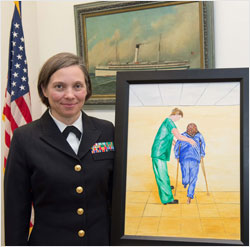U.S. Navy Captain Donates Service-Inspired Painting to NMHM
Dec. 3, 2013, Silver Spring, Md.: A painting titled "Learning to Walk" depicts a moment of cooperation and compassion between two women from different parts of the world. Its artist, U.S. Navy CAPT Patricia L. McKay, has chosen to share that story with visitors to the National Museum of Health and Medicine (NMHM) by donating the work of art to the museum.
McKay created the painting for "Wounded in Action: An Art Exhibition of Orthopaedic Advancements," an exhibit of art works inspired by individuals' experiences with the wounds of war sponsored by the American Academy of Orthopaedic Surgeons. "Learning to Walk" was on display as part of the two-year exhibition that traveled to six U.S. cities, including an approximately year-long engagement at NMHM. Inspired by McKay's experiences while deployed on the USNS Comfort in 2003, the acrylic painting is based on a photograph McKay took of an American physical therapist helping an 18-year-old Iraqi female amputee learn to walk on crutches. After spending several weeks working up a first draft of the painting, McKay said it only took her two nights to complete what would become the final version.
"When the 'Wounded in Action' project came out, this was the image that came to mind," said McKay, who serves as Assistant Dean for Clinical Sciences at the Uniformed Services University of the Health Sciences (USU) in Bethesda, Md.
McKay said she was struck by the colors in the photograph and "the effort that she [the Iraqi girl] was making to learn to walk again." She explained that she also saw a distinct contrast between the two women; the American physical therapist had the freedom to go anywhere and do anything, while the patient had very limited opportunities because of her nationality, gender and physical challenges.
"Yet, this physical therapist is taking care of these women who were absolutely convinced that their future held nothing more than being a beggar," McKay said, adding the Iraqi girl in the picture, "saw no future for herself."
In an effort to help the girl gain some practical skills, McKay said she taught her to use a sewing machine, which McKay had brought onto the ship to use in her spare time.
"I actually took the sewing machine down to the ward and had her sit at the machine and learn to use it, thinking maybe she would be able to see she could still do so many things," McKay said. "She had never seen a sewing machine before, but we had some fabric and some material and she just hemmed this hijab [the head covering she wears in the painting]—we gave her the fabric for that."
McKay said the girl stayed on the hospital ship for approximately six weeks until the Comfort was given orders to return to the United States. She does not know what happened to the girl, but thinks it is possible she may have been able to obtain a prosthetic limb upon returning to Iraq.
"We all hope that her life has been better than she expected it would be," McKay said.
McKay, who specializes in orthopedics and is also a hand surgeon at Walter Reed National Military Medical Center and Fort Meade, said she hopes that when people see the painting, they will walk away with a sense of how important it is to help others.
"For me, it's about compassion for our fellow human beings, and the willingness to reach across cultures and try to raise each other up," she said. "And I think that those of us who were the providers [on the ship] gained as much from that experience as we gave to the patients."
About the National Museum of Health and Medicine
- The National Museum of Health and Medicine, established in 1862, is a Department of Defense museum that inspires interest in and promotes the understanding of medicine -- past, present, and future -- with a special emphasis on tri-service American military medicine. As a National Historic Landmark recognized for its ongoing value to the health of the military and to the nation, the Museum identifies, collects, and preserves important and unique resources to support a broad agenda of innovative exhibits, educational programs, and scientific, historical, and medical research. The Museum has relocated to 2500 Linden Lane, Silver Spring, Md., 20910. Visit the Museum website at www.medicalmuseum.mil or call (301) 319-3300.
 |
Caption: U.S. Navy CAPT Patricia L. McKay (left), Assistant Dean for Clinical Sciences at the Uniformed Services University of the Health Sciences in Bethesda, Md., and Eric Boyle, archivist in the Otis Historical Archives at the National Museum of Health and Medicine (NMHM), stand with her painting "Learning to Walk" at NMHM. "Learning to Walk" portrays a scene McKay witnessed while deployed with the USNS Comfort during Operation Iraqi Freedom. McKay recently donated her painting to NMHM, following its inclusion in "Wounded in Action: An Art Exhibition of Orthopaedic Advancements" by the American Academy of Orthopaedic Surgeons. (National Museum of Health and Medicine/Released) |
 |
Caption: U.S. Navy CAPT Patricia L. McKay, Assistant Dean for Clinical Sciences at the Uniformed Services University of the Health Sciences in Bethesda, Md., stands with her painting "Learning to Walk" at the National Museum of Health and Medicine (NMHM). "Learning to Walk" portrays a scene McKay witnessed while deployed with the USNS Comfort during Operation Iraqi Freedom. McKay recently donated her painting to NMHM, following its inclusion in "Wounded in Action: An Art Exhibition of Orthopaedic Advancements" by the American Academy of Orthopaedic Surgeons. (National Museum of Health and Medicine/Released) |



